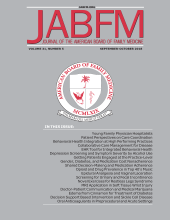Research ArticleOriginal Research
Measuring Performance in Primary Care: What Patient Outcome Indicators Do Physicians Value?
Paul L. Dassow
The Journal of the American Board of Family
Medicine January 2007, 20 (1) 1-8; DOI: https://doi.org/10.3122/jabfm.2007.01.060082

References
- ↵HEDIS Benchmarks [homepage on the internet]. Washington (DC): National Committee for Quality Assurance [cited 10 May 2006]. Available from: http://www.ncqa.org.
- ↵Tarlov AR, Ware JE Jr., Greenfield S, Nelson EC, Perrin E, Zubkoff M. The Medical Outcomes Study. An application of methods for monitoring the results of medical care. JAMA 1989; 262: 925–30.
- ↵McHorney CA. Generic health measurement: past accomplishments and a measurement paradigm for the 21st century. Ann Intern Med 1997; 127: 743–50.
- ↵AQA [homepage on the internet]. The Ambulatory Care Quality Alliance; ©2005 [cited 2006 May 10]. Available from http://www.ambulatoryqualityalliance.org.
- ↵AQA Workgroup Membership. The Ambulatory Care Quality Alliance; c2005 [cited 10 May 2006]. Available from: http://www.ambulatoryqualityalliance.org/files/AQAWorkgroupMembershipLists.doc.
- ↵
- ↵Resolution No. 302 (Kentucky A) [cited 20 Sept 2006]. Available from: http://www.aafp.org.
- ↵Kaplan RM, Anderson JP. The General Health Policy Model: An integrated approach. In: Spilker B, editor. Quality of life and pharmacoeconomics in clinical trials. New York: Raven Press; 1996. p. 309.
- Ware JE, Sherbourne CD. The MOS 36-item short form health survey. Conceptual framework and item selection. Med Care 1988; 30: 473–83.
- ↵Stewart AL, Ware JE. Measuring functioning and well-being: the medical outcomes study approach. Durham (NC): Duke University Press; 1992.
- Nelson E, Wasson J, Kirk J, et al. Assessment of function in routine clinical practice: Description of the COOP chart method and preliminary findings. J Chron Dis 1987; 40: 55S–63S.
- Parkerson GR, Gehlbach SH, Wagner EH, James SA, Clapp NE, Muhlbaier LH. The Duke-UNC Health Profile: An adult health status instrument for primary care. Med Care 1981; 19: 806–28.
- Hunt SM, McEwen J. The development of a subjective health indicator. Soc Health Illness 1980; 2: 232–46.
- Bergner M, Bobbitt RA, Kressel S, Pollard WE, Gilson BJ, Morris JR. The Sickness Impact Profile: conceptual formulation and methodology for the development of a health status measure. Int J Health Serv 1976; 6: 393–415.
- Jette AM, Davies AR, Cleary PD, et al. The Functional Status Questionnaire: reliability and validity when used in primary care. J Gen Intern Med 1986; 1: 143–9.
- ↵World Health Organization. Constitution of the World Health Organization. New York: World Health Organization; 1947.
- ↵
- ↵Williams TR. Practical design and implementation considerations in pay-for-performance programs. Am J Man Care 2006; 12: 77–80.
- ↵
- ↵
- ↵
In this issue
The Journal of the American Board of Family
Medicine
Vol. 20, Issue 1
January-February 2007
Measuring Performance in Primary Care: What Patient Outcome Indicators Do Physicians Value?
Paul L. Dassow
The Journal of the American Board of Family
Medicine Jan 2007, 20 (1) 1-8; DOI: 10.3122/jabfm.2007.01.060082
Jump to section
Related Articles
- No related articles found.






